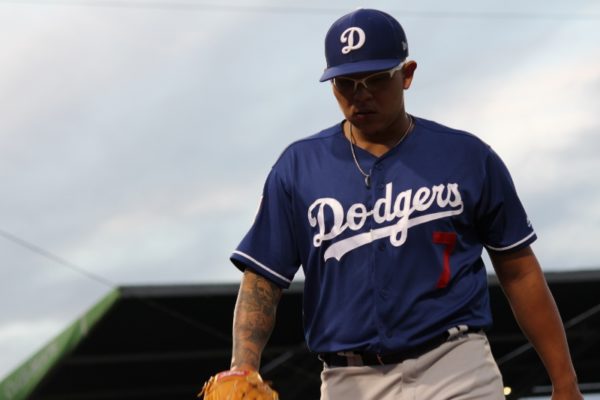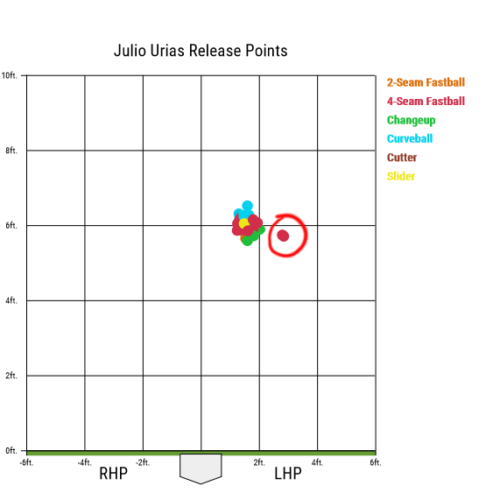Julio Urias’ return to the mound as a starter this week was nothing short of joyful. Watching him turn in a gem (abbreviated only due to pitch limits) against the Giants was just plain fun. He had command of all of his pitches, which provided plenty of excellent GIF fodder. It was the type of outing fans could only dream of a year ago, and it speaks to an incredibly promising season and career going forward.
It’s irresponsible to draw substantive conclusions from Urías’ one start, so a deep-dive analysis isn’t warranted yet. That will take awhile, especially since he is moving back to the bullpen shortly. Instead, we can look at a smaller fun thing. Urías threw two pitches on Monday which particularly pushed my “pitching nerd” buttons, so let’s look at them. Here is the first, a fastball to Gerardo Parra:
And here is the second, a fastball to Joe Panik:
These two fastballs were Urías’ two hardest velocities of the night, both clocking in at 96.8 MPH, according to PitchInfo. Both missed their target quite badly to the arm side and high, with the first finding a good spot to complete a strikeout, and the second finding Panik’s ribs to allow a rare baserunner. Despite the velocity, the pitches don’t seem all that interesting on the surface.
However, it was the way in which Urías threw the pitches which makes them warrant attention, particularly because it shows what information he is absorbing from his teammates. Here is a plot of Urías’ release points during his Monday start, with the two pitches of interest circled:
Indeed, Urías is a member of the Dodger fraternity of left-handed starting pitchers who selectively drop their arm slot in order to create extra deception. Here are what Urías’ two deliveries look like side-by-side:
This isn’t new, and it started with the Dodgers’ acquisition of Rich Hill in July of 2016. Here are Urías’ release points by game that season, and you can see things start to change in August, shortly after Hill joined the Dodgers:
Though there is evidence that Urías picked up the drop-down technique from Hill in 2016, he abandoned it the following year, potentially due to his shoulder issues. He began using it more frequently in the bullpen last season, and has obviously carried it back into a starting role.
As we established, this originated with Hill, the most famous current user of the technique. An intrepid freelancer took a look at this for The Athletic last year, detailing how Hill used varying arm angles late in the season to fuel a hot streak. The arm slot drop has been a big part of how he can survive with just two pitches, since it turns those two into five unique offerings.
Hill famously passed that tactic to Clayton Kershaw in late 2016. Like Urías, Kershaw’s drop-down mechanics give him a more cross-fire action. Also like Urías, Kershaw’s drop-down pitches have higher velocities than his normal over-the-top offerings. Here are Kershaw’s two arm slots overlaid. Kershaw’s lower arm slot mechanics in particular are extremely similar to the ones shown by Urías:
Due to those similarities, Urías can take away some lessons from Kershaw’s use of the second arm slot. Kershaw’s drop-down became a de-facto pitch tip when he introduced it, since he only threw fastballs from the lower arm angle. While the movement and velocity surprised some hitters, there were some who were obviously prepared and were ready to ambush the pitch. Eventually Kershaw began to mix in curves from that slot, which helped remove predictability. These days, Kershaw only seems to mix in the low arm slot when he’s healthy and comfortable, so it has become increasingly rare to see.
What remains to be seen is how Urías will use this trickery when he returns to the bullpen. Both Hill and Kershaw use the arm slot drop to help give them different looks on later trips through a lineup. This situation won’t be applicable to Urías shortly. However, since he varied his arm slot in relief last year, it will probably continue going forward. It’s probably a good thing to keep practicing, especially since the two pitches on Monday showed that it’s still a work in progress.
——
For now, it’s just fun to think about Urías absorbing information from a future Hall Of Famer and another excellent lefty teammate. It’s something which has become a weird Dodger quirk that doesn’t really show up in the rest of the league, a little thing which makes the team more unique. I have a real soft spot for it and seeing it spread, particularly to somebody as young and promising as Urías. It’s a small thing, but it’s a fun thing, and another reason to be thankful that baseball is back.
 Dodgers Digest Los Angeles Dodgers Baseball Blog
Dodgers Digest Los Angeles Dodgers Baseball Blog

